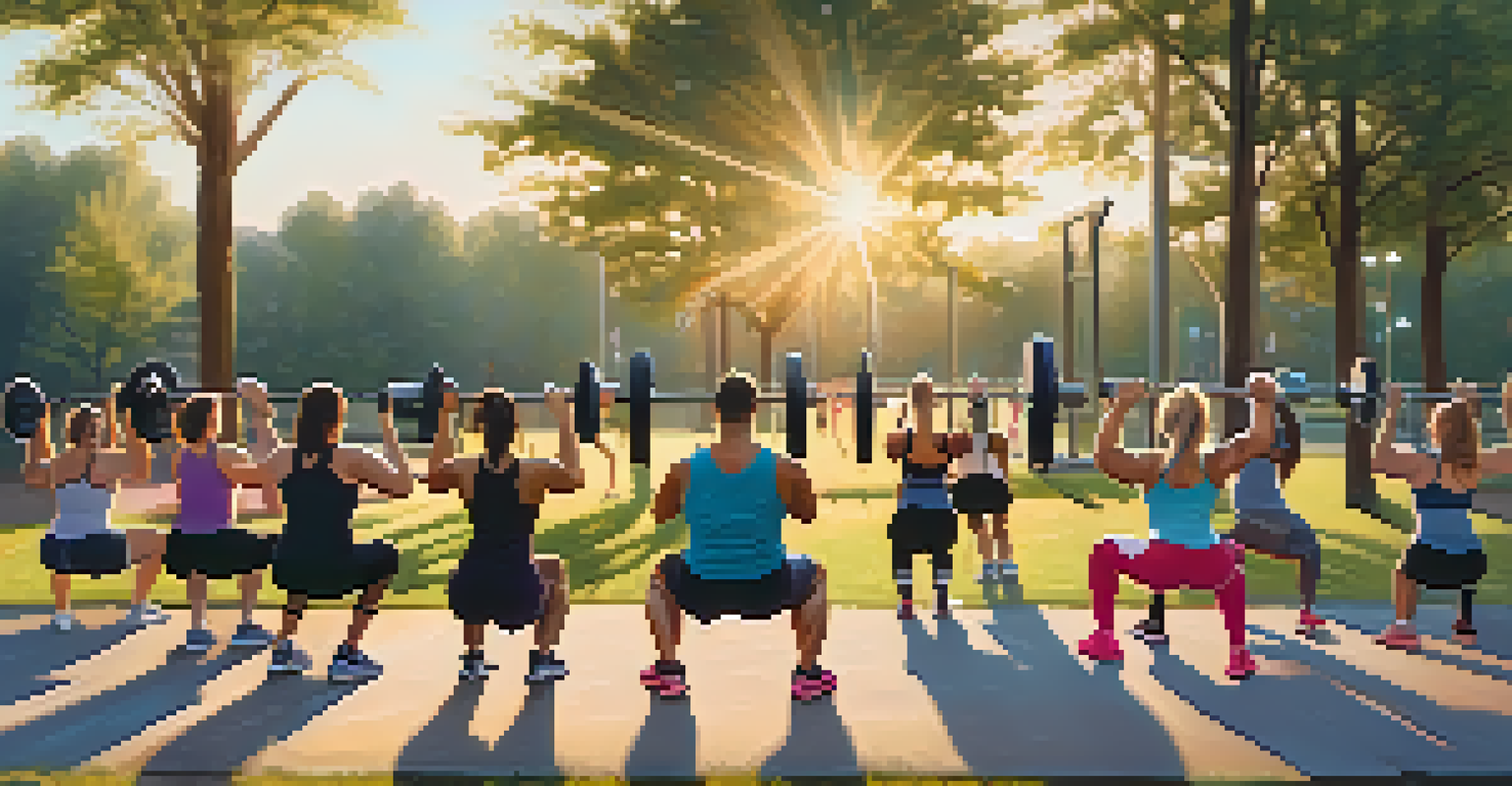Front Squats: A Key Variation for Building Core Strength

Understanding Front Squats and Their Benefits
Front squats are a fantastic variation of the traditional squat that emphasizes the anterior chain of your body, particularly your core muscles. Unlike back squats, where the barbell rests on your upper back, front squats require you to hold the barbell at your chest, forcing your body to engage your core more intensely. This positioning not only enhances your strength but also promotes better posture and balance.
Strength does not come from physical capacity. It comes from an indomitable will.
One of the primary benefits of front squats is their ability to build core strength, which is vital for overall stability and athletic performance. A strong core supports nearly all movements, from lifting to running, and helps prevent injuries. By incorporating front squats into your routine, you’re not just working on your legs; you’re also fortifying your midsection, which can lead to improved performance in various activities.
Additionally, front squats can be particularly beneficial for those with lower back issues. The upright position of the torso during the lift reduces the strain on the lumbar spine, making it a safer alternative for many individuals. This makes front squats an excellent choice for anyone looking to strengthen their legs and core while minimizing the risk of injury.
How to Perform Front Squats Correctly
To perform a front squat, start by standing with your feet shoulder-width apart. Position the barbell across the front of your shoulders, using either a clean grip or a cross-arm grip to hold it securely. Ensure that your elbows are high and your chest is lifted to maintain an upright posture throughout the movement.

As you begin the squat, push your hips back and bend your knees simultaneously, lowering yourself down as if you’re sitting on a chair. Keep your core engaged and your back straight to avoid leaning forward excessively. Aim to lower yourself until your thighs are parallel to the ground or lower, depending on your mobility and comfort level.
Core Strength and Stability
Front squats build core strength, essential for stability and injury prevention in various activities.
Once you reach the bottom of the squat, pause briefly before pushing through your heels to return to the starting position. It’s important to exhale on the way up and maintain control throughout the movement. Like any exercise, practice makes perfect, so take your time to master the form before attempting heavier weights.
Common Mistakes to Avoid When Front Squatting
Even though front squats are an excellent addition to any workout routine, it's crucial to perform them correctly to avoid injuries. One common mistake is allowing the elbows to drop during the squat. This can lead to a forward lean, which puts extra pressure on your lower back and can compromise your form. Keeping your elbows high helps maintain an upright torso and engages your core effectively.
The more you sweat in training, the less you bleed in combat.
Another frequent error is not squatting low enough. While everyone’s mobility is different, aim for at least parallel to the ground to fully engage your muscles. If you find it challenging to get low, consider working on your ankle and hip mobility with specific stretches and drills outside of your squatting routine.
Lastly, avoid using excessively heavy weights before mastering the movement. Start with lighter weights to focus on your form and technique, gradually increasing the load as you become more comfortable. Remember, quality over quantity is key when it comes to any strength training exercise.
Integrating Front Squats into Your Workout Routine
Incorporating front squats into your workout routine can be straightforward and rewarding. You can include them in your leg day workout, performing them after your warm-up and before other compound lifts. A simple set of 3-4 sets of 8-12 reps can effectively boost your strength while allowing for adequate recovery between sets.
If you’re looking to enhance your core strength further, consider supersetting front squats with core-focused exercises like planks or hanging leg raises. This combination not only maximizes your workout time but also reinforces the core engagement you achieve with front squats. Mixing in variations like pause squats or tempo squats can also keep your training fresh and challenging.
Proper Technique is Key
Mastering the correct form in front squats is crucial for maximizing benefits and avoiding injuries.
Additionally, consider varying your grip style to challenge your body in different ways. Switching between the clean grip and cross-arm grip can change the emphasis on certain muscle groups and help you find what feels most comfortable for you. As with any exercise, listening to your body is essential, so adjust your routine based on how you feel.
Front Squats and Athletic Performance
Front squats are not just for building strength; they also play a significant role in enhancing athletic performance. Many athletes benefit from this squat variation due to its emphasis on core stability, which is vital for nearly all sports. Whether you’re running, jumping, or twisting, a strong core translates to better control and power in your movements.
In sports like basketball or soccer, where quick direction changes are common, the core strength developed from front squats can make a noticeable difference. Athletes who incorporate front squats into their training often experience improved agility and balance, helping them perform better during games and competitions. This makes front squats a must for anyone serious about their athletic training.
Moreover, front squats can help improve your overall explosive strength, which is crucial for activities that require quick bursts of power, like sprinting or jumping. By integrating front squats into your regimen, you’ll not only build muscle but also enhance your functional strength, allowing you to perform at your peak.
The Role of Mobility in Front Squats
Mobility plays a critical role in executing front squats effectively. Good ankle, hip, and thoracic spine mobility are essential for achieving the proper squat depth and maintaining an upright posture. If you're struggling with these aspects, it can lead to suboptimal performance and increased injury risk.
To improve your mobility, consider incorporating dynamic stretches and mobility drills into your warm-up routine. Exercises such as ankle dorsiflexion stretches, hip openers, and thoracic spine rotations can enhance your range of motion and make it easier to perform front squats with proper form. The more mobile you are, the better your squat will be.
Mobility Enhances Performance
Improving mobility aids in achieving proper squat depth and posture, leading to better overall performance.
In some cases, using a weightlifting shoe with a raised heel can also assist in achieving a better squat position. These shoes provide additional stability and support, allowing for a deeper squat without compromising your form. Making mobility a priority in your training will ultimately lead to better front squat performance and overall strength gains.
Benefits of Front Squats Beyond the Gym
While front squats are an excellent exercise for building strength, their benefits extend beyond the gym. The core strength developed through this movement can enhance your everyday activities, making tasks like lifting heavy objects or maintaining good posture easier and safer. This is especially important as we age, as maintaining core strength helps prevent falls and injuries.
Additionally, front squats can improve your overall body awareness and coordination. As you focus on balancing the barbell in front of you, you become more attuned to your body’s movements. This increased awareness can translate into better performance in other physical activities, from recreational sports to daily errands.

Finally, the discipline and focus required to master front squats can foster a greater sense of confidence and accomplishment. As you progress and lift heavier weights, you’ll likely find yourself feeling more empowered both in and out of the gym. This boost in self-esteem can have a positive ripple effect on other areas of your life, making front squats a truly holistic exercise.